A Markov Chain-Based Bias Correction Method for Simulating the Temporal Sequence of Daily Precipitation
Abstract
1. Introduction
2. Study Area and Data Sources
2.1. Study Area
2.2. Data Sources
3. Methodology
3.1. Quantile Mapping Bias Correction Method
3.2. The First-Order Two-State Markov Chain
3.3. Hybrid Bias Correction Method
- (a)
- Taking January as an example, the total precipitation of this month over the whole period is sorted in ascending order and then separated into dry and wet groups. Then the mean monthly precipitation is calculated from each group. The daily series corresponded to the months in each group are gathered and used to calculate P01 and P11. With this step, a set of P01, P11, and the mean monthly precipitation is calculated for each group.
- (b)
- The total precipitation of this month each year is also divided into two, even periods in chronological order. A set of parameters is also calculated for each period.
- (c)
- A linear equation is established for P01 (and P11) and the mean monthly precipitation based on the four samples calculated from step-(a) and step-(b).
3.4. Analysis Procedure And Statistics
4. Results
4.1. Validation of the Daily Bias Correction
4.2. Validation of the Linear Relationships
4.3. Performance of the MCBC Method
5. Discussions and Conclusions
Author Contributions
Funding
Acknowledgments
Conflicts of Interest
References
- Chen, J.; Brissette, F.P.; Poulin, A.; Leconte, R. Overall uncertainty study of the hydrological impacts of climate change for a Canadian watershed. Water Resour. Res. 2011, 47. [Google Scholar] [CrossRef]
- Jeong, H.; Bhattarai, R.; Hwang, S. How climate scenarios alter future predictions of field-scale water and nitrogen dynamics and crop yields. J. Environ. Manag. 2019, 252, 109623. [Google Scholar] [CrossRef] [PubMed]
- Ramirez-Villegas, J.; Challinor, A.J.; Thornton, P.K.; Jarvis, A. Implications of regional improvement in global climate models for agricultural impact research. Environ. Res. Lett. 2013, 8, 024018. [Google Scholar] [CrossRef]
- Wang, G. Agricultural drought in a future climate: Results from 15 global climate models participating in the IPCC 4th assessment. Clim. Dyn. 2005, 25, 739–753. [Google Scholar] [CrossRef]
- Chen, J.; Brissette, F.P.; Leconte, R. Uncertainty of downscaling method in quantifying the impact of climate change on hydrology. J. Hydrol. 2011, 401, 190–202. [Google Scholar] [CrossRef]
- Chen, J.; Chen, H.; Guo, S. Multi-site precipitation downscaling using a stochastic weather generator. Clim. Dyn. 2017, 50, 1975–1992. [Google Scholar] [CrossRef]
- Martins, M.A.; Tomasella, J.; Dias, C.G. Maize yield under a changing climate in the Brazilian Northeast: Impacts and adaptation. Agric. Water Manag. 2019, 216, 339–350. [Google Scholar] [CrossRef]
- Jakob Themeßl, M.; Gobiet, A.; Leuprecht, A. Empirical-statistical downscaling and error correction of daily precipitation from regional climate models. Int. J. Climatol. 2011, 31, 1530–1544. [Google Scholar] [CrossRef]
- Troin, M.; Velázquez, J.A.; Caya, D.; Brissette, F. Comparing statistical post-processing of regional and global climate scenarios for hydrological impacts assessment: A case study of two Canadian catchments. J. Hydrol. 2015, 520, 268–288. [Google Scholar] [CrossRef]
- Chen, J.; Brissette, F.P.; Chaumont, D.; Braun, M. Performance and uncertainty evaluation of empirical downscaling methods in quantifying the climate change impacts on hydrology over two North American river basins. J. Hydrol. 2013, 479, 200–214. [Google Scholar] [CrossRef]
- Ines, A.V.; Hansen, J.W. Bias correction of daily GCM rainfall for crop simulation studies. Agric. For. Meteorol. 2006, 138, 44–53. [Google Scholar] [CrossRef]
- Maraun, D.; Shepherd, T.G.; Widmann, M.; Zappa, G.; Walton, D.; Gutiérrez, J.M.; Mearns, L.O. Towards process-informed bias correction of climate change simulations. Nat. Clim. Chang. 2017, 7, 764–773. [Google Scholar] [CrossRef]
- Manzanas, R.; Gutiérrez, J.M.; Bhend, J.; Hemri, S.; Doblas-Reyes, F.J.; Torralba, V.; Penabad, E.; Brookshaw, A. Bias adjustment and ensemble recalibration methods for seasonal forecasting: A comprehensive intercomparison using the C3S dataset. Clim. Dyn. 2019, 53, 1287–1305. [Google Scholar] [CrossRef]
- Caya, D.; Laprise, R. A semi-implicit semi-lagrangian regional climate model: The canadian rcm. Mon. Weather Rev. 1999, 127, 341–362. [Google Scholar] [CrossRef]
- Teutschbein, C.; Seibert, J. Regional Climate Models for Hydrological Impact Studies at the Catchment Scale: A Review of Recent Modeling Strategies. Geogr. Compass 2010, 4, 834–860. [Google Scholar] [CrossRef]
- Zhang, X.C.; Chen, J.; Garbrecht, J.D.; Brissette, F.P. Evaluation of a weather generator-based method for statistically downscaling non-stationary climate scenarios for impact at point scale. Trans. ASAE 2012, 55, 1745–1756. [Google Scholar] [CrossRef]
- Fowler, H.J.; Ekström, M.; Blenkinsop, S.; Smith, A.P. Estimating change in extreme European precipitation using a multimodel ensemble. J. Geophys. Res. 2007, 112. [Google Scholar] [CrossRef]
- Murphy, J. An Evaluation of Statistical and Dynamical Techniques for Downscaling Local Climate. J. Clim. 1999, 12, 2256–2284. [Google Scholar] [CrossRef]
- Zhang, X.C. Verifying a temporal disaggregation method for generating daily precipitation of potentially non-stationary climate change for site-specific impact assessment. Int. J. Climatol. 2013, 33, 326–342. [Google Scholar] [CrossRef]
- Cannon, A.J.; Sobie, S.R.; Murdock, T.Q. Bias Correction of GCM Precipitation by Quantile Mapping: How Well Do Methods Preserve Changes in Quantiles and Extremes? J. Clim. 2015, 28, 6938–6959. [Google Scholar] [CrossRef]
- Chen, J.; Brissette, F.P.; Chaumont, D.; Braun, M. Finding appropriate bias correction methods in downscaling precipitation for hydrologic impact studies over North America. Water Resour. Res. 2013, 49, 4187–4205. [Google Scholar] [CrossRef]
- Teutschbein, C.; Seibert, J. Bias correction of regional climate model simulations for hydrological climate-change impact studies: Review and evaluation of different methods. J. Hydrol. 2012, 456, 12–29. [Google Scholar] [CrossRef]
- Hnilica, J.; Hanel, M.; Puš, V. Multisite bias correction of precipitation data from regional climate models. Int. J. Climatol. 2017, 37, 2934–2946. [Google Scholar] [CrossRef]
- Rosenberg, E.A.; Keys, P.W.; Booth, D.B.; Hartley, D.; Burkey, J.; Steinemann, A.C.; Lettenmaier, D.P. Precipitation extremes and the impacts of climate change on stormwater infrastructure in Washington State. Clim. Chang. 2010, 102, 319–349. [Google Scholar] [CrossRef]
- Schoof, J.T.; Shin, D.W.; Cocke, S.; LaRow, T.E.; Lim, Y.K.; O’Brien, J.J. Dynamically and statistically downscaled seasonal temperature and precipitation hindcast ensembles for the southeastern USA. Int. J. Climatol. 2009, 29, 243–257. [Google Scholar] [CrossRef]
- Roosmalen, L.V.; Christensen, J.H.; Butts, M.B.; Jensen, K.H.; Refsgaard, J.C. An intercomparison of regional climate model data for hydrological impact studies in Denmark. J. Hydrol. 2010, 380, 406–419. [Google Scholar] [CrossRef]
- Schmidli, J.; Frei, C.; Vidale, P.L. Downscaling from GCM precipitation: A benchmark for dynamical and statistical downscaling methods. Int. J. Climatol. 2006, 26, 679–689. [Google Scholar] [CrossRef]
- Themeßl, M.J.; Gobiet, A.; Heinrich, G. Empirical-statistical downscaling and error correction of regional climate models and its impact on the climate change signal. Clim. Chang. 2012, 112, 449–468. [Google Scholar] [CrossRef]
- Shen, M.; Chen, J.; Zhuan, M.; Chen, H.; Xu, C.-Y.; Xiong, L. Estimating uncertainty and its temporal variation related to global climate models in quantifying climate change impacts on hydrology. J. Hydrol. 2018, 556, 10–24. [Google Scholar] [CrossRef]
- Chen, J.; Zhang, X.J.; Brissette, F.P. Assessing scale effects for statistically downscaling precipitation with GPCC model. Int. J. Climatol. 2014, 34, 708–727. [Google Scholar] [CrossRef]
- Ines, A.V.; Hansen, J.W.; Robertson, A.W. Enhancing the utility of daily GCM rainfall for crop yield prediction. Int. J. Climatol. 2011, 31, 2168–2182. [Google Scholar] [CrossRef]
- Maraun, D.; Wetterhall, F.; Ireson, A.M.; Chandler, R.E.; Kendon, E.J.; Widmann, M.; Brienen, S.; Rust, H.W.; Sauter, T.; Themeßl, M.; et al. Precipitation downscaling under climate change: Recent developments to bridge the gap between dynamical models and the end user. Rev. Geophys. 2010, 48. [Google Scholar] [CrossRef]
- Rajczak, J.; Kotlarski, S.; Schär, C. Does Quantile Mapping of Simulated Precipitation Correct for Biases in Transition Probabilities and Spell Lengths? J. Clim. 2016, 29, 1605–1615. [Google Scholar] [CrossRef]
- Chen, J.; Brissette, F.P. Comparison of five stochastic weather generators in simulating daily precipitation and temperature for the Loess Plateau of China. Int. J. Climatol. 2014, 34, 3089–3105. [Google Scholar] [CrossRef]
- Chen, J.; Brissette, F.P.; Leconte, R. A daily stochastic weather generator for preserving low-frequency of climate variability. J. Hydrol. 2010, 388, 480–490. [Google Scholar] [CrossRef]
- Chen, J.; Brissette, F.P.; Leconte, R. Downscaling of weather generator parameters to quantify hydrological impacts of climate change. Clim. Res. 2012, 51, 185–200. [Google Scholar] [CrossRef]
- Moon, S.-E.; Ryoo, S.-B.; Kwon, J.-G. A Markov chain model for daily precipitation occurrence in South Korea. Int. J. Climatol. 1994, 14, 1009–1016. [Google Scholar] [CrossRef]
- Wilks, D.S. Multisite generalization of a daily stochastic precipitation generation model. J. Hydrol. 1998, 210, 178–191. [Google Scholar] [CrossRef]
- Wilks, D.S. Interannual variability and extreme-value characteristics of several stochastic daily precipitation models. Agric. For. Meteorol. 1999, 93, 153–169. [Google Scholar] [CrossRef]
- Wilks, D.S. Multisite downscaling of daily precipitation with a stochastic weather generator. Clim. Res. 1999, 11, 125–136. [Google Scholar] [CrossRef]
- Wilks, D.S.; Wilby, R.L. The weather generation game: A review of stochastic weather models. Prog. Phys. Geogr. 1999, 23, 329–357. [Google Scholar] [CrossRef]
- Apipattanavis, S.; Podestá, G.; Rajagopalan, B.; Katz, R.W. A semiparametric multivariate and multisite weather generator. Water Resour. Res. 2007, 43, 1973–1989. [Google Scholar] [CrossRef]
- Gu, L.; Chen, J.; Xu, C.-Y.; Wang, H.-M.; Zhang, L. Synthetic Impacts of Internal Climate Variability and Anthropogenic Change on Future Meteorological Droughts over China. Water 2018, 10, 1702. [Google Scholar] [CrossRef]
- Zhuan, M.-J.; Chen, J.; Shen, M.-X.; Xu, C.-Y.; Chen, H.; Xiong, L.-H. Timing of human-induced climate change emergence from internal climate variability for hydrological impact studies. Hydrol. Res. 2018, 49, 421–437. [Google Scholar] [CrossRef]
- Mpelasoka, F.S.; Chiew, F.H. Influence of Rainfall Scenario Construction Methods on Runoff Projections. J. Hydrometeorol. 2009, 10, 1168–1183. [Google Scholar] [CrossRef]
- Gabriel, K.R.; Neumann, J. A markov chain model for daily rainfall occurrence at tel aviv. Q. J. R. Meteorol. Soc. 2010, 88, 90–95. [Google Scholar] [CrossRef]
- Li, Z.; Brissette, F.; Chen, J. Assessing the applicability of six precipitation probability distribution models on the Loess Plateau of China. Int. J. Climatol. 2014, 34, 462–471. [Google Scholar] [CrossRef]
- Heim, R.R. A Review of Twentieth-Century Drought Indices Used in the United States. Bull. Am. Meteorol. Soc. 2002, 83, 1149–1166. [Google Scholar] [CrossRef]
- Wilks, D.S. Adapting stochastic weather generation algorithms for climate change studies. Clim. Chang. 1992, 22, 67–84. [Google Scholar] [CrossRef]
- Schoof, J.T.; Pryor, S.C. On the Proper Order of Markov Chain Model for Daily Precipitation Occurrence in the Contiguous United States. J. Appl. Meteorol. Climatolo. 2008, 47, 2477–2486. [Google Scholar] [CrossRef]
- Zhang, X.C.; Garbrecht, J.D. Evaluation of CLIGEN precipitation parameters and their implication on WEPP runoff and erosion prediction. Tran. ASAE 2003, 46, 311. [Google Scholar]
- Iman, R.L.; Conover, W.J. A distribution-free approach to inducing rank correlation among input variables. Commun. Stat. Simul. Comput. 2007, 11, 311–334. [Google Scholar] [CrossRef]
- Li, Z. A new framework for multi-site weather generator: A two-stage model combining a parametric method with a distribution-free shuffle procedure. Clim. Dyn. 2013, 43, 657–669. [Google Scholar] [CrossRef]
- Zhang, X.C. Generating correlative storm variables for CLIGEN using a distribution-free approach. Trans. ASAE 2005, 48, 567–575. [Google Scholar] [CrossRef]
- Li, X.; Babovic, V. Multi-site multivariate downscaling of global climate model outputs: An integrated framework combining quantile mapping, stochastic weather generator and Empirical Copula approaches. Clim. Dyn. 2019, 52, 5775–5799. [Google Scholar] [CrossRef]
- Li, X.; Babovic, V. A new scheme for multivariate, multisite weather generator with inter-variable, inter-site dependence and inter-annual variability based on empirical copula approach. Clim. Dyn. 2019, 52, 2247–2267. [Google Scholar] [CrossRef]
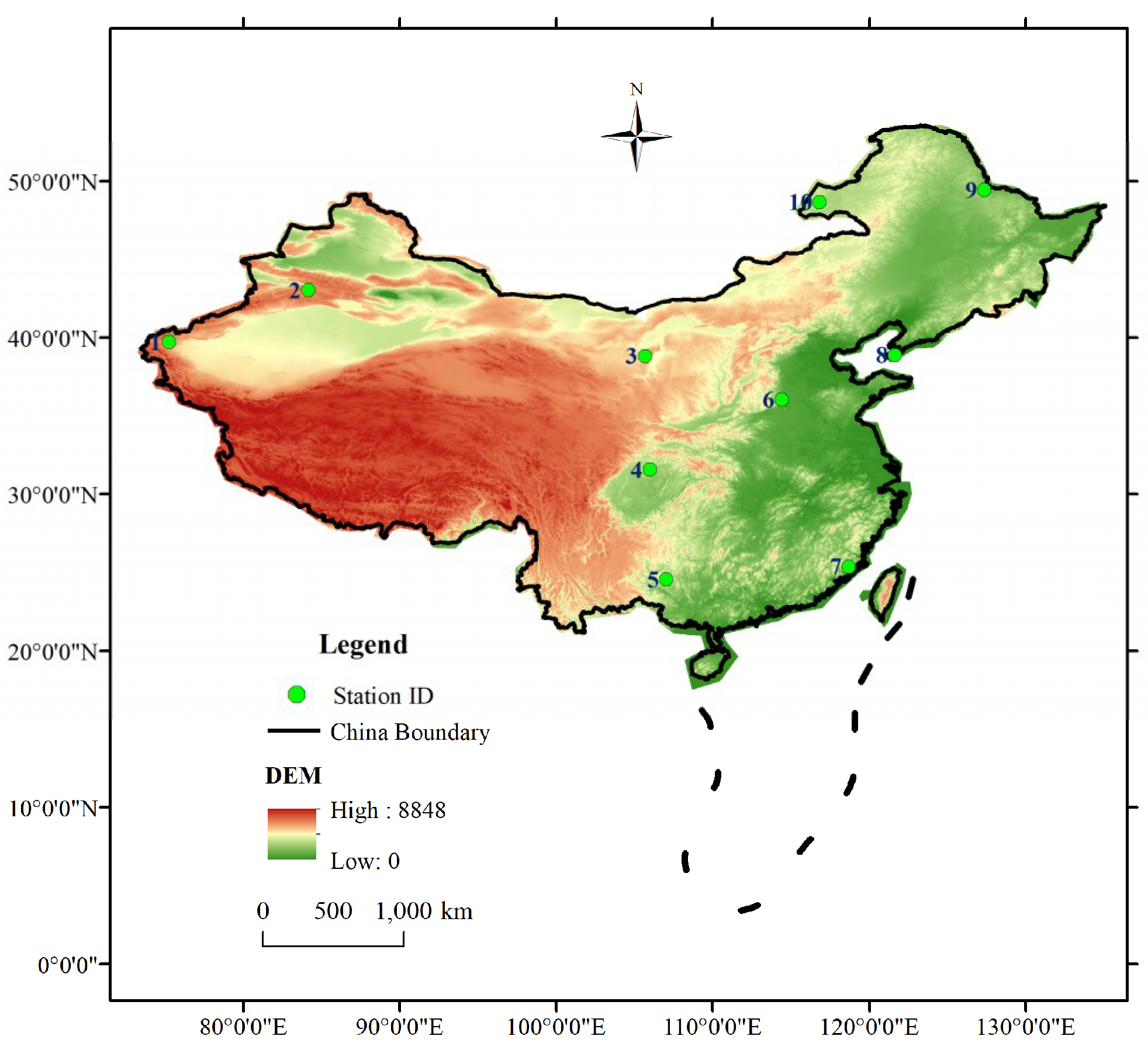
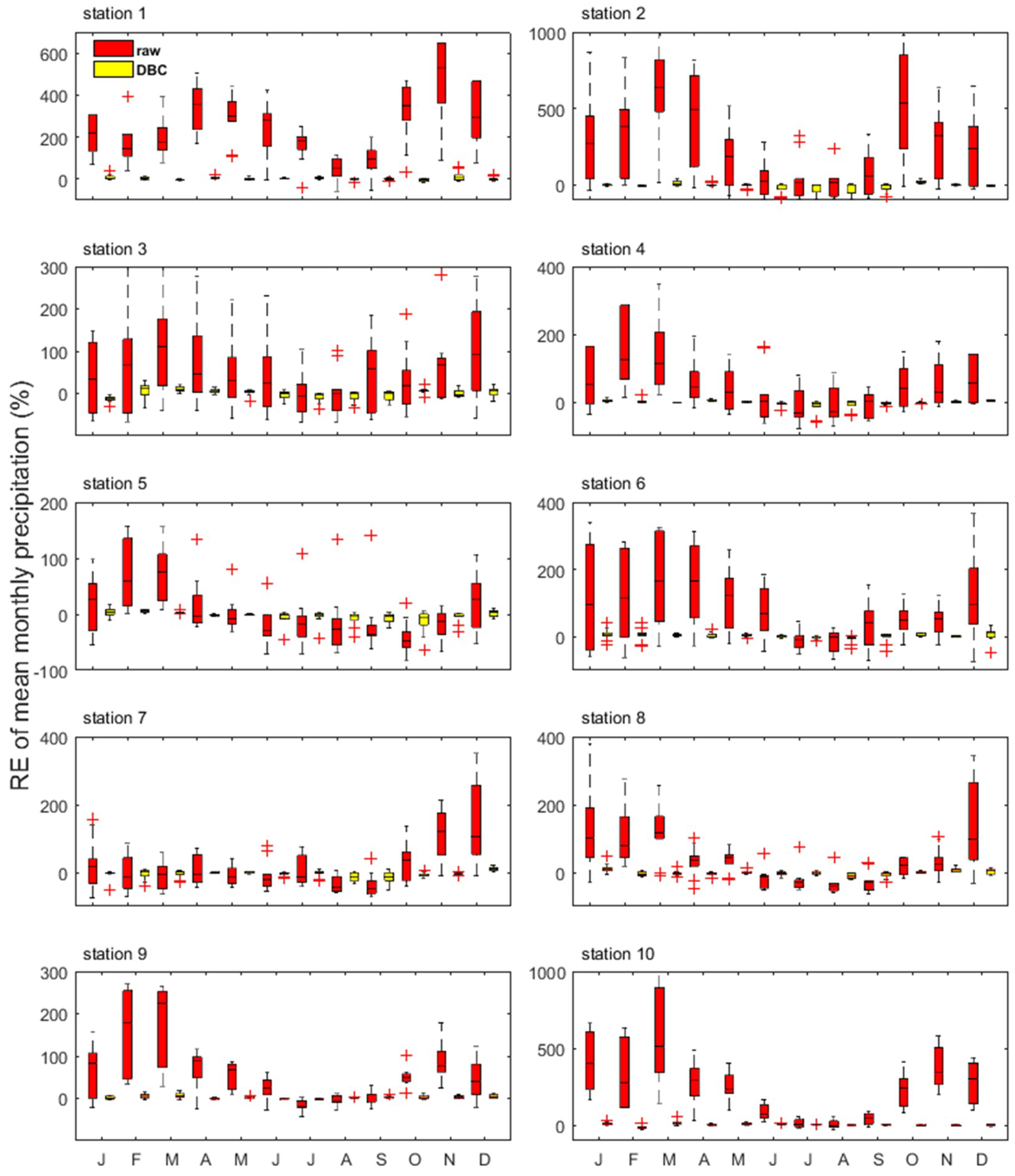
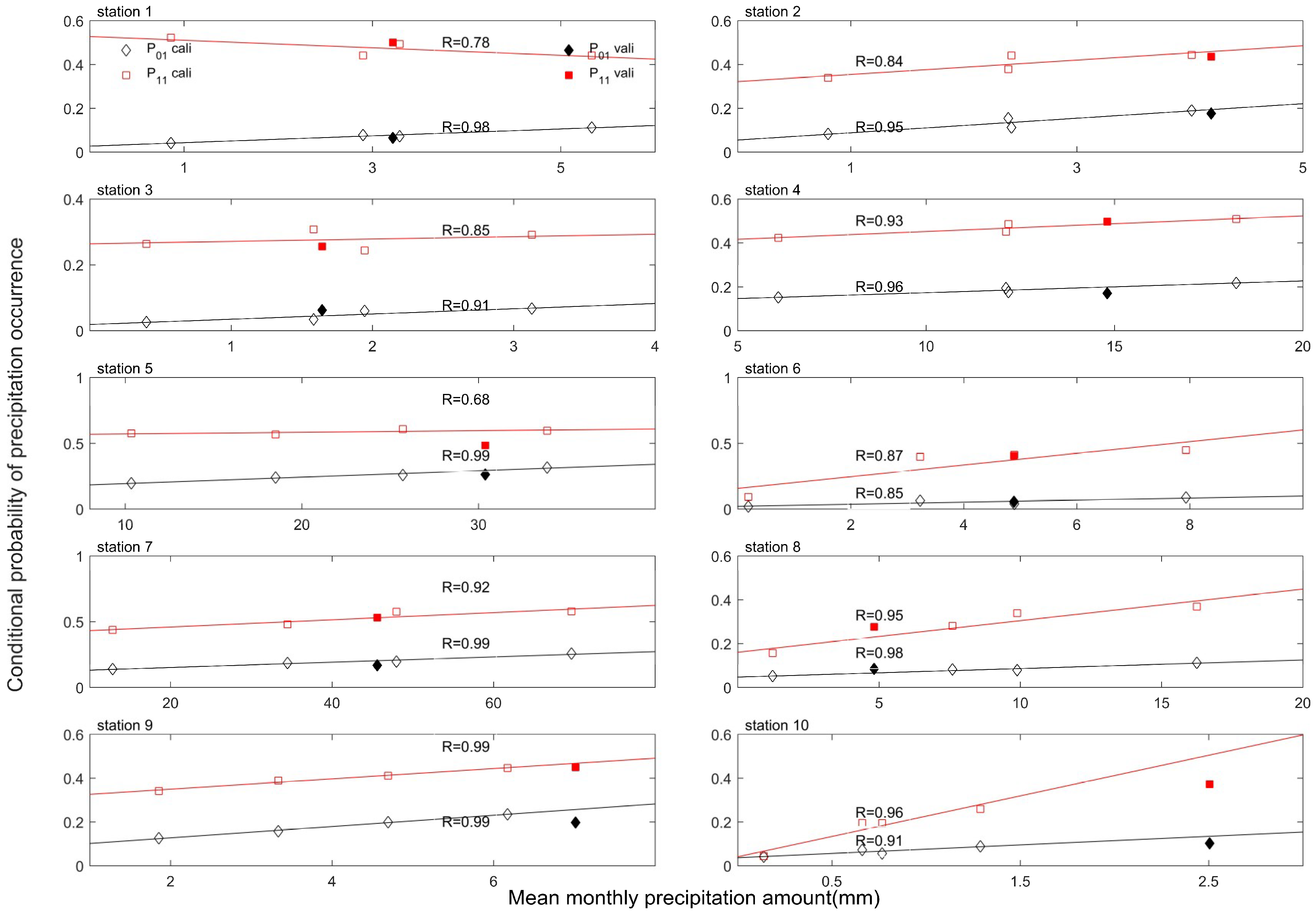
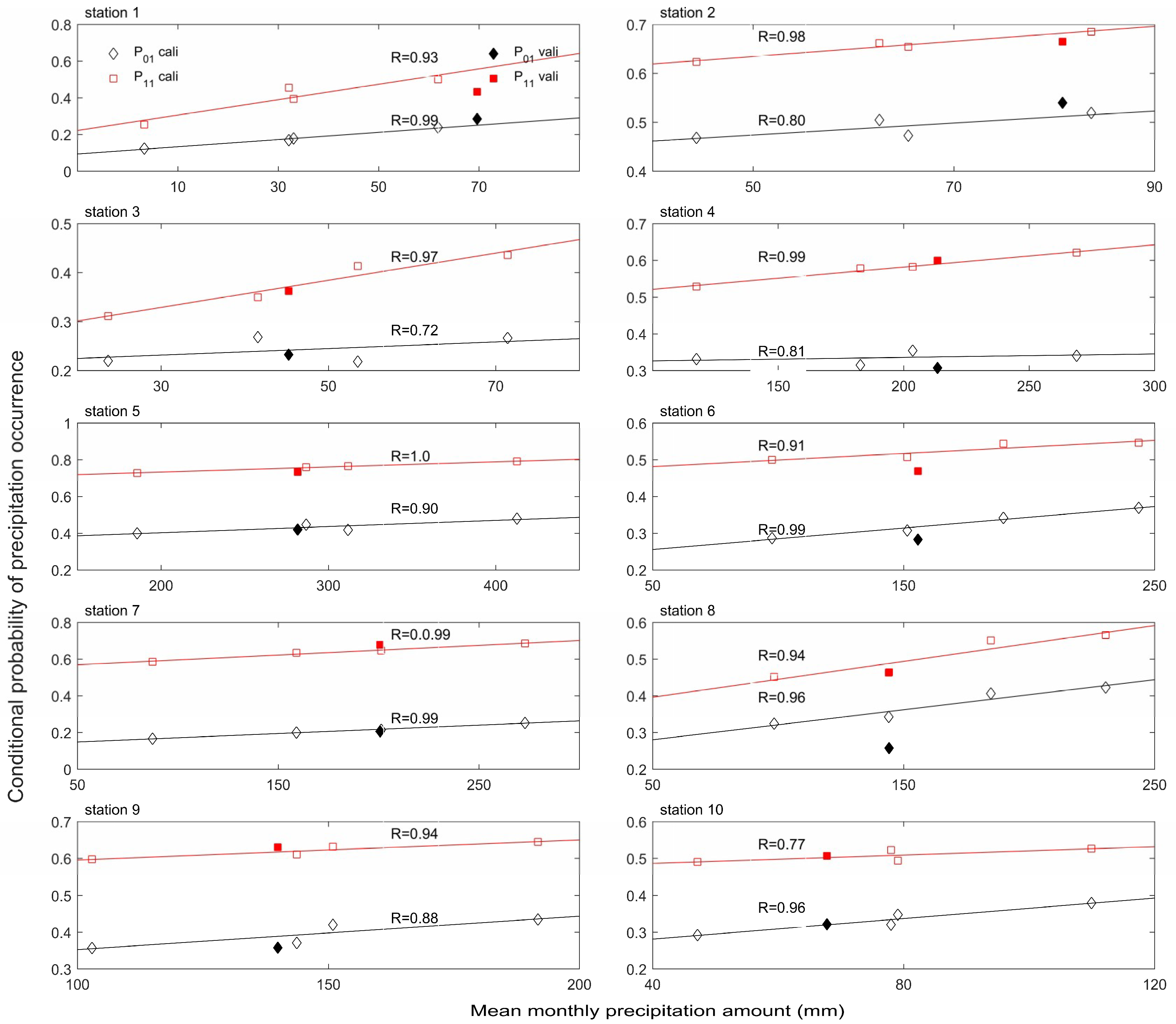
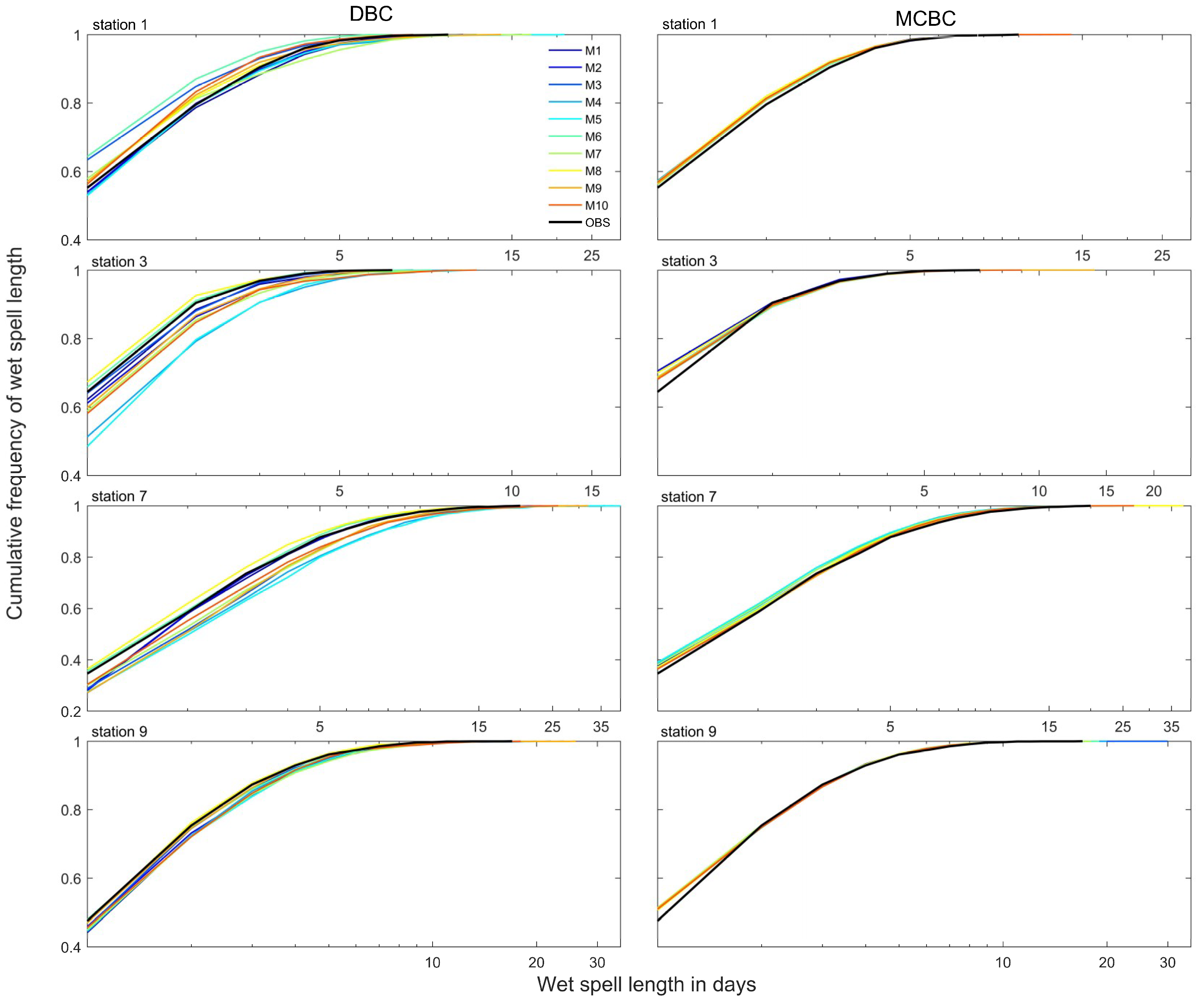
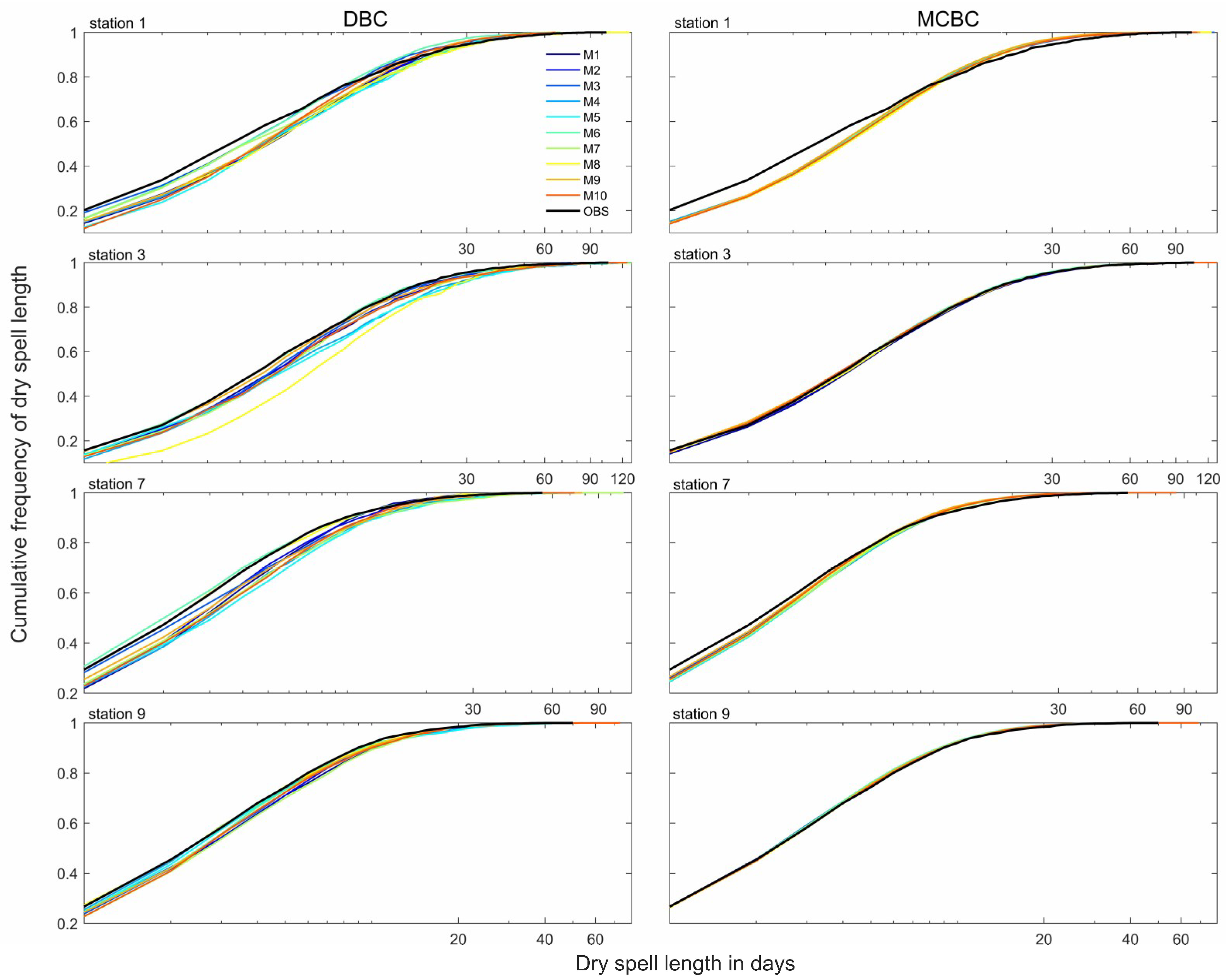
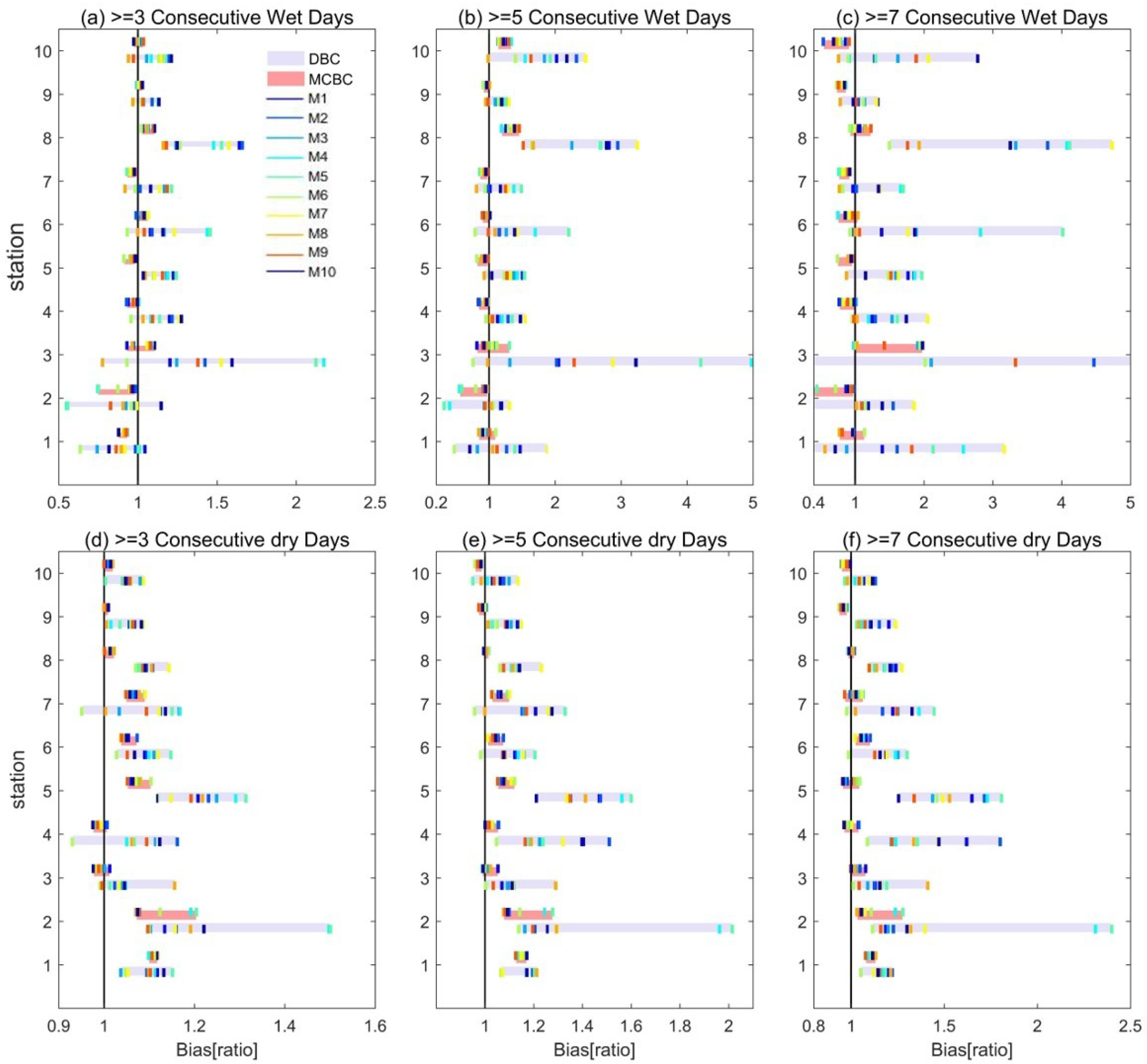
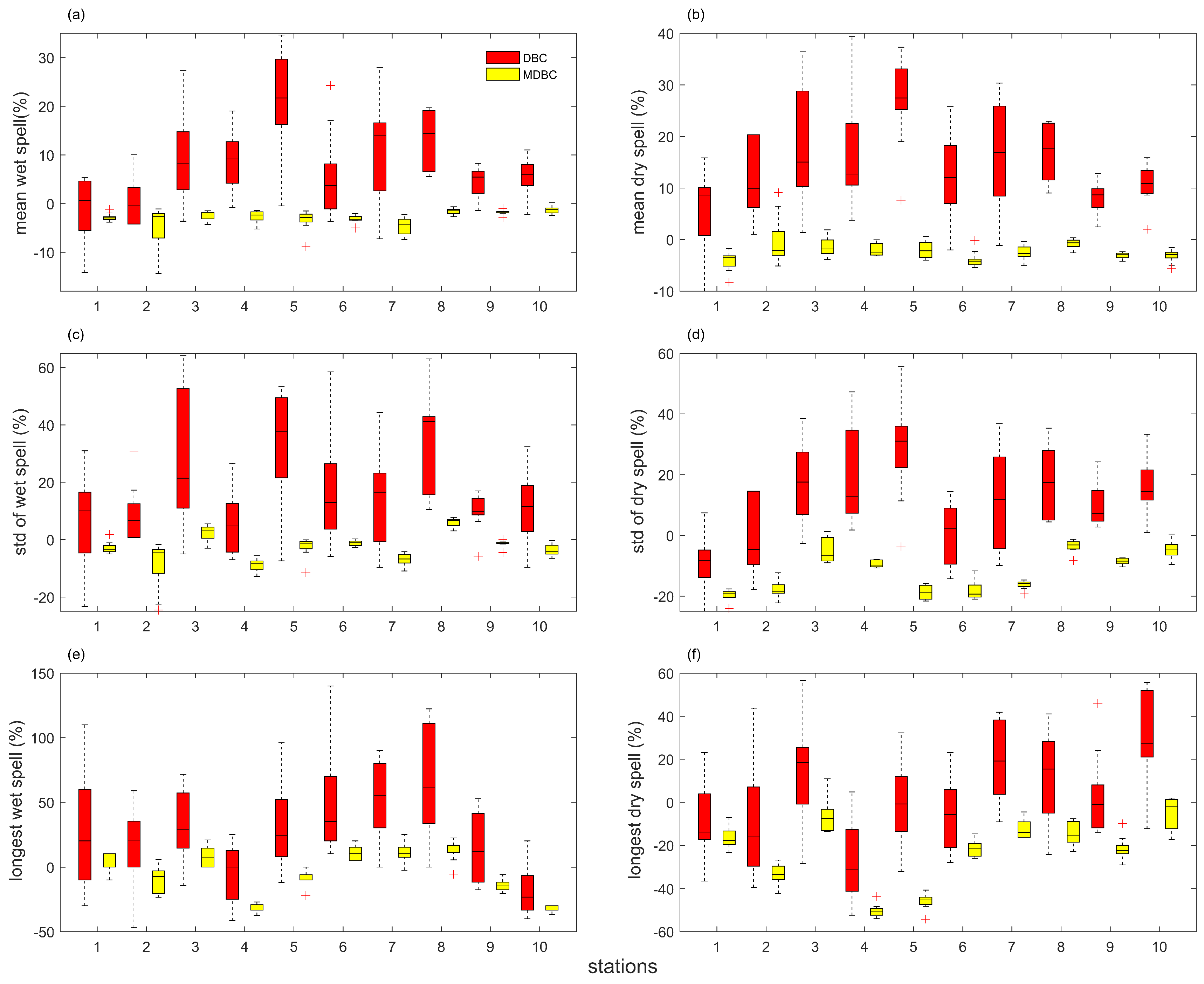
| Station | Name | Latitude (°N) | Longitude (°E) | Elevation (m) | Mean Annual Precipitation (mm) | Wet Day Frequency |
|---|---|---|---|---|---|---|
| 1 | Wuqia | 39.72 | 75.25 | 2176 | 185 | 0.18 |
| 2 | Bayinbuluke | 43.03 | 84.15 | 2458 | 277 | 0.32 |
| 3 | Alashanzuoqi | 38.83 | 105.67 | 1561 | 209 | 0.15 |
| 4 | Langzhong | 31.58 | 105.97 | 383 | 1028 | 0.37 |
| 5 | Fengshan | 24.55 | 107.03 | 487 | 1526 | 0.44 |
| 6 | Anyang | 36.05 | 114.40 | 63 | 562 | 0.20 |
| 7 | Xianyou | 25.37 | 118.70 | 800 | 1565 | 0.39 |
| 8 | Dalian | 38.90 | 121.63 | 92 | 623 | 0.21 |
| 9 | Sunwu | 49.43 | 127.35 | 210 | 540 | 0.32 |
| 10 | Xinerbahuyouqi | 48.67 | 116.82 | 554 | 241 | 0.18 |
| No. | Model Name | Modelling Centre | Source | Spatial Resolution (Longitude × Latitude) |
|---|---|---|---|---|
| 1 | ACCESS-1.0 | CRIRO-BOM | Commonwealth Scientific and Industrial Research Organization (CSIRO) and Bureau of Meteorology (BOM), Australia | 1.875° × 1.25° |
| 2 | CESM1-CAM5 | NSF-DOE-NCAR | National Science Foundation, Department of Energy National Center for Atmospheric Research | 1.25° × 0.94° |
| 3 | CMCC-CM | CMCC | Centro Euro-Mediterraneo per I Cambiamenti Climatici | 0.75° × 0.75° |
| 4 | CSIRO-Mk3-6.0 | CSIRO-QCCCE | Commonwealth Scientific and Industrial Research Organization in collaboration with Queensland Climate Change Centre of Excellence | 1.90° × 1.90° |
| 5 | FGOALS-G2 | LASG-CESS | LASG, Institute of Atmospheric Physics, Chinese Academy of Sciences and CESS, Tsinghua University | 2.81° × 3.00° |
| 6 | GFDL-ESM2G | NOAA GFDL | NOAA Geophysical Fluid Dynamics Laboratory | 2.50° × 2.0° |
| 7 | GFDL-ESM2M | |||
| 8 | MIROC5 | MIPOC | Atmosphere and Ocean Research Institute (The University of Tokyo), National Institute for Environmental Studies, and Japan Agency for Marine-Earth Science and Technology | 1.40° × 1.40° |
| 9 | MRI-CGCM3 | MRI | Meteorological Research Institute | 1.10° × 1.10° |
| 10 | MRI-ESM1 | 1.13° × 1.13° |
© 2020 by the authors. Licensee MDPI, Basel, Switzerland. This article is an open access article distributed under the terms and conditions of the Creative Commons Attribution (CC BY) license (http://creativecommons.org/licenses/by/4.0/).
Share and Cite
Liu, H.; Chen, J.; Zhang, X.-C.; Xu, C.-Y.; Hui, Y. A Markov Chain-Based Bias Correction Method for Simulating the Temporal Sequence of Daily Precipitation. Atmosphere 2020, 11, 109. https://doi.org/10.3390/atmos11010109
Liu H, Chen J, Zhang X-C, Xu C-Y, Hui Y. A Markov Chain-Based Bias Correction Method for Simulating the Temporal Sequence of Daily Precipitation. Atmosphere. 2020; 11(1):109. https://doi.org/10.3390/atmos11010109
Chicago/Turabian StyleLiu, Han, Jie Chen, Xun-Chang Zhang, Chong-Yu Xu, and Yu Hui. 2020. "A Markov Chain-Based Bias Correction Method for Simulating the Temporal Sequence of Daily Precipitation" Atmosphere 11, no. 1: 109. https://doi.org/10.3390/atmos11010109
APA StyleLiu, H., Chen, J., Zhang, X.-C., Xu, C.-Y., & Hui, Y. (2020). A Markov Chain-Based Bias Correction Method for Simulating the Temporal Sequence of Daily Precipitation. Atmosphere, 11(1), 109. https://doi.org/10.3390/atmos11010109







